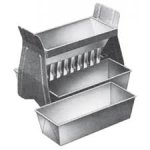In about 45 years of reloading, all I ever did was as Brassman suggests - use up one jug, and open the next. Never worried about "lot numbers" or paid much attention to it. I never seemed to have issues with rounds for deer hunting. But, I now have an acquaintance coaching me for loading up a rifle for longer range "gong" shooting - apparently "mixing powder lots so do not have to re-work up load" is the thing to do. Hence my query about how is that done, to know they are actually mixed, as opposed to just all poured into the same container.
When I first started hand loading, going to the LGS and picking up a pound of powder, was a hit and miss affair. Same for components.
That was a time when any rifle shooting consistent 2-3 inch groups was considered accurate. To say that bullet jackets were a consistent thickness all the way around or over their length, meant they could vary as much as fifteen thousandths in and still be acceptable.
Powder lots could vary so much from one lot to the next, that one lot would be safe at a certain charge and the next was showing high pressure or low pressures.
Just over 50 years ago, the powder available was often repackaged surplus, left over from WWII and the Korean War.
The Viet Nam War was gobbling up most of the newly made powders.
In Canada, were lucky because some of the powders available were made here, but quality control wasn't tight.
My first experience with mixing different lot numbers to get consistent burn rates over relatively large amounts of powder, was from a fellow working for Kesselring's/Burlington, Washington. I was just getting serious about accuracy.
Kesselring's was the only place that I could get custom swaged bullets, which today wouldn't be considered match quality. Not only that, they had a shooting range behind the store. The range was great, because I could actually try out some of the bullets and powder before purchasing them.
When you purchased powder, there were bins of the different powders they had available. You scooped out as much as you wanted into a brown paper bag and were charged by the weight.
When I spoke with the fellow, in charge of the powder and components for match shooting, he very proudly stated that the powders in the bins were some of the most consistent I would likely be able to find anywhere. Then he went on to explain how they brought in the powder in 50 pound kegs and mixed them all together, like Ganderite mentioned in a cement mixer before putting them into the hoppers for the bins.
I hadn't even considered it, I was close to the bottom of the learning curve back then. After speaking to the fellow, who really knew his stuff, I was convinced.
Understand, I was quit spoiled when it came to powder. I purchased large quantities of surplus powder directly from Hodgdon. Usually in 25 pound laminated and coated paper containers, but if they weren't available, I took the 50 pound drums. It was available in larger drums as well, but I had to be able to unload it by hand.
The bigger the drums, the cheaper it was.
I've been blending different lots of the same powder for close to 50 years and never thought anything of it. WHY?? It's perfectly safe, as long as you don't mix powders of different designations.
Everything utilized for hand loading has gotten better over the decades. Cannister grade powders are very consistent between lots, but not always.
With the invention of the Juenke thickness guage, which was a transducer that measured thickness in metal tubing and accurate to within .001 in. It was based on the transducers used for, I believe, were used for measuring the thickness of nuclear rods.
That was around 1980.
Everything started to really change as far as accuracy was concerned with the use of the Juenke tester to make bullet jackets and brass cases.
That's when the companies producing cartridge powders had to up their end game and make their powder burn rates more consistent from lot to lot. Cannister grade powders, which most people use, are better now than they've ever been IMHO. Still, every once in a while, the reloader gets a surprise that they can't explain.
Maybe it's just an old habit, but I've been blending different lots of the same powder for a long time and likely will always do so. I have recipes that I haven't changed over 30 years for the same rifle, if I have enough bullets to continue with that load. Changing bullet lots can and does make a difference, even though the product number on the box is the same.
Primers can throw a wrench into things as well.
I'll stop now. I've gotten off topic. Still it's related as far as consistency goes.








































































